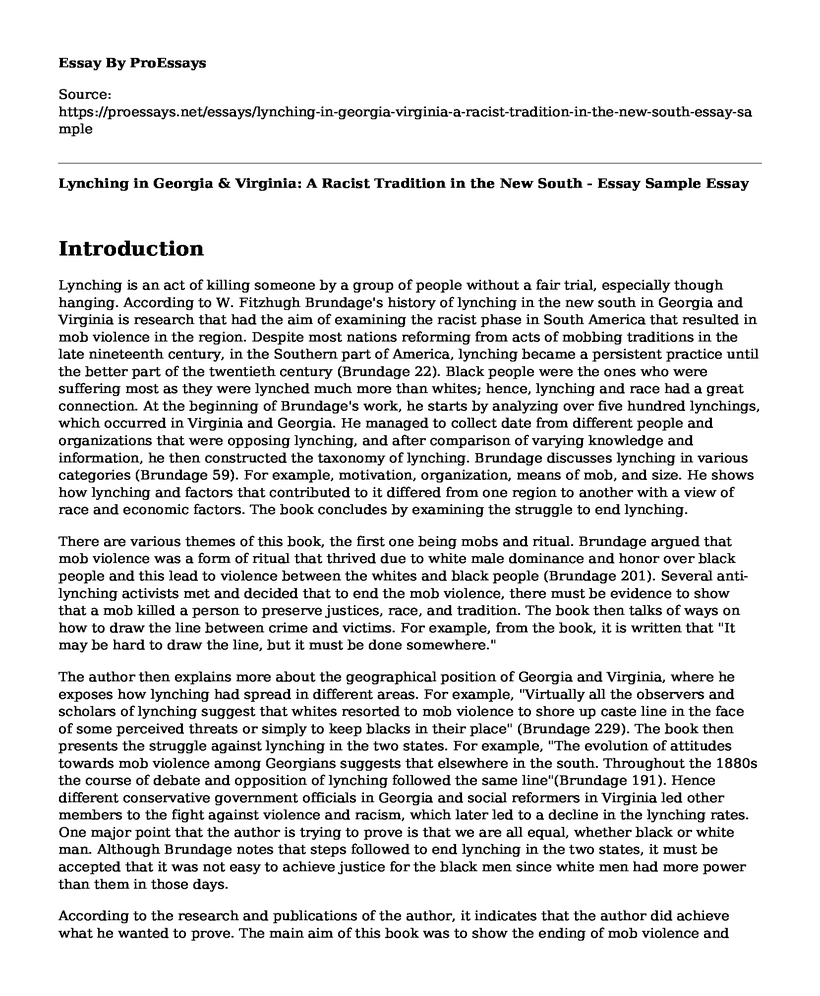Introduction
Lynching is an act of killing someone by a group of people without a fair trial, especially though hanging. According to W. Fitzhugh Brundage's history of lynching in the new south in Georgia and Virginia is research that had the aim of examining the racist phase in South America that resulted in mob violence in the region. Despite most nations reforming from acts of mobbing traditions in the late nineteenth century, in the Southern part of America, lynching became a persistent practice until the better part of the twentieth century (Brundage 22). Black people were the ones who were suffering most as they were lynched much more than whites; hence, lynching and race had a great connection. At the beginning of Brundage's work, he starts by analyzing over five hundred lynchings, which occurred in Virginia and Georgia. He managed to collect date from different people and organizations that were opposing lynching, and after comparison of varying knowledge and information, he then constructed the taxonomy of lynching. Brundage discusses lynching in various categories (Brundage 59). For example, motivation, organization, means of mob, and size. He shows how lynching and factors that contributed to it differed from one region to another with a view of race and economic factors. The book concludes by examining the struggle to end lynching.
There are various themes of this book, the first one being mobs and ritual. Brundage argued that mob violence was a form of ritual that thrived due to white male dominance and honor over black people and this lead to violence between the whites and black people (Brundage 201). Several anti-lynching activists met and decided that to end the mob violence, there must be evidence to show that a mob killed a person to preserve justices, race, and tradition. The book then talks of ways on how to draw the line between crime and victims. For example, from the book, it is written that "It may be hard to draw the line, but it must be done somewhere."
The author then explains more about the geographical position of Georgia and Virginia, where he exposes how lynching had spread in different areas. For example, "Virtually all the observers and scholars of lynching suggest that whites resorted to mob violence to shore up caste line in the face of some perceived threats or simply to keep blacks in their place" (Brundage 229). The book then presents the struggle against lynching in the two states. For example, "The evolution of attitudes towards mob violence among Georgians suggests that elsewhere in the south. Throughout the 1880s the course of debate and opposition of lynching followed the same line"(Brundage 191). Hence different conservative government officials in Georgia and social reformers in Virginia led other members to the fight against violence and racism, which later led to a decline in the lynching rates. One major point that the author is trying to prove is that we are all equal, whether black or white man. Although Brundage notes that steps followed to end lynching in the two states, it must be accepted that it was not easy to achieve justice for the black men since white men had more power than them in those days.
According to the research and publications of the author, it indicates that the author did achieve what he wanted to prove. The main aim of this book was to show the ending of mob violence and lynching in the Southern United States, and at the end, we see lynching declining through the efforts of reformed and civilized people. Brundage knew what he was writing about because he could research and compare the work of other earlier scholars; hence, he had full knowledge of lynching.
Some of the sources of information used by the author to extract information about lynching in the two states were local newspapers, the NAACP, the report from Tuskegee Institute, and the ASWPL. By combining these resources, he was able to gain enough knowledge concerning lynching both in Georgia and Virginia. Brundage utilized sources mention above and focus on the two States to address three keys questions in his text, which ignored by other precious studies. The questions accounts for thesis in the book include, to what level was lynching a social ritual that emphasized traditional values? What results to decline of lynching in the two States? How can the difference in lynching over time and space be explained?.In conclusion, the primary flaw in Lynching in the New South is Brundage's overemphasis on regional diversity. A comparison of two states in the Deep South, where lynching was more prevalent, would have demonstrated a higher degree of continuity and gone further toward explaining the phenomenon of lynching. The author asserts that lynching was considered America's national crime, but lynching also became a southern obsession. However, he also explains many of the complex factors that contributed to racial violence in the South. Lynching in the New South is an essential book because it answers many of the questions ignored by past research.
Work Cited
Brundage, W.Fitzhug. Lynching in the New South: Georgia and Virginia, 1880-1930. Urbana: University of Illinois Press, 1993.
Cite this page
Lynching in Georgia & Virginia: A Racist Tradition in the New South - Essay Sample. (2023, Feb 27). Retrieved from https://proessays.net/essays/lynching-in-georgia-virginia-a-racist-tradition-in-the-new-south-essay-sample
If you are the original author of this essay and no longer wish to have it published on the ProEssays website, please click below to request its removal:
- Critical Thinking on the Sex Tourism Problem
- Child Abuse in US Foster Care System Annotated Bibliorgraphy
- Essay Sample on Human Rights Tribunal of Alberta
- Research Paper on Gun Violence in Our Society
- Research Paper on Al-Qaeda
- Immigrants and Firms Productivity Essay Example
- Testing on Human Vs Testing on Animals Essay Example







